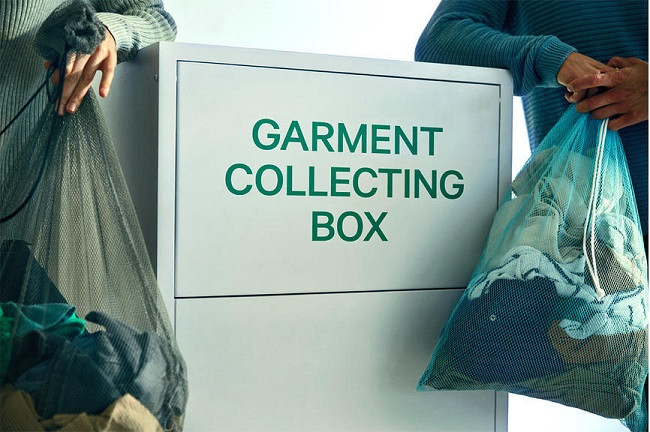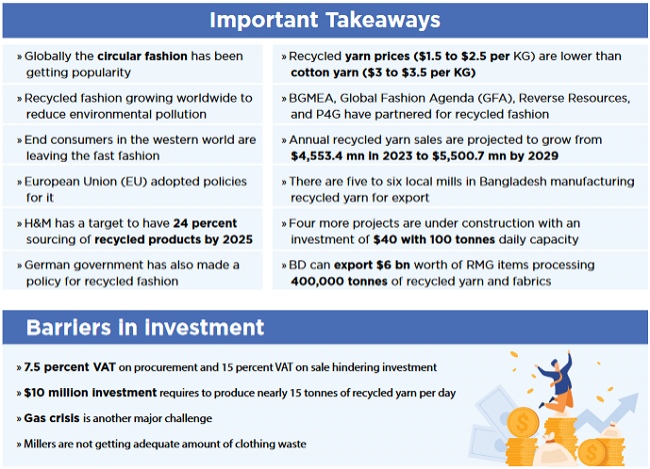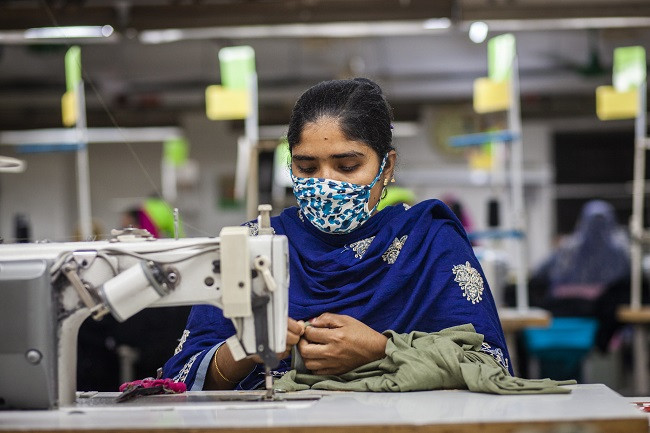Bangladesh should get ready for recycled fashion as the major international clothing retailers and brands are focusing more on the circular fashion to save the environment and for the mother earth from pollution.
Globally the circular fashion has been getting popularity as the end consumers in the western world are leaving the fast fashion mainly to reduce the consumption.

In fast fashion it needs more fabrics, more cultivation of cotton and more transportation of goods and so many factors all of which are related to more consumption of water, more carbon emission and more pollution of environment.
But the recycled fashion means less carbon emission, less water consumption and less environmental pollution because of reuse, reduce of waste materials and recycle of the waste of clothing.
In the recycled fashion, the old clothes are collected and those are washed and reused by making them renewed.
Moreover, the wastages of garment fabrics are also recycled and made yarn from these items to make new garment items.
Why the recycled fashion is growing
The recycled fashion is growing worldwide mainly to reduce the environmental pollution and for saving the Mother Earth.
So almost all the international clothing retailers and brands have also started rethinking about the global fashion and business.
The European Union (EU) the largest exporting bloc for Bangladesh, has already adopted a policy for shifting their fashion consumption to recycled fashion from fast fashion.
The EU has announced that by 2030, all of its garment items would have to be sourced from recycled yarn.
Accordingly, the Swedish retail giant H&M has already asked the local garment suppliers to shift production to recycled materials from fast fashion.
The H&M has a target to have 24 percent of its apparel sourced from recycled or sustainable materials by 2025.
So, the company has already suggested the local suppliers to go for recycled fashion.
The German government has also made a policy as German due diligence for recycled fashion so that the world can be made pollution free by reusing reducing and refusing of materials.
A big number of end consumers have already started leaving the fast fashion and adopting their purchasing behavior to recycled fashion.
Status of global recycled fashion
The BGMEA, Global Fashion Agenda (GFA), Reverse Resources, and P4G have partnered in an initiative “Circular Fashion Partnership” that aims to achieve a long-term, scalable transition to a circular fashion system.
Over 30 renowned fashion brands, manufacturers and recyclers are collaborating in the new initiative to capture and reuse textile waste in Bangladesh, according to a statement from the BGMEA.

Global Fashion Agenda announced the participants of the Circular Fashion Partnership, including the global brands Bershka, Bestseller, C&A, Gina Tricot, Grey State, H&M Group, Kmart Australia, Marks & Spencer, OVS, Pull & Bear, Peak Performance and Target Australia, the BGMEA said in the statement.
The partnership facilitates circular commercial collaborations between major fashion brands, textile and garment manufacturers, and recyclers to develop and implement new systems to capture and direct post-production fashion waste back into the production of new fashion products.
It plans to facilitate a decrease in textile waste and increase the use of recycled fibres, distributing value throughout the fashion value cycle and generating economic benefits in Bangladesh by accelerating the fiber recycling market.
The initiative is focusing on Bangladesh as it arguably possesses the most in-demand and recyclable waste of any garment producing country, but the majority of its waste is currently being exported and/or downcycled.
Globally, annual sales of recycled yarn are projected to grow from $4,553.4 million in 2023 to $5,500.7 million by 2029 at a compound annual growth rate of 3.2 percent, according to QY, a California-based global research organization.
China accounts for about 60 percent of the trade followed by the US with a share of about 16 percent, it said.
Status of recycled fashion in Bangladesh
Bangladesh is still lagging behind competitors in the production of recycled yarn and transit to recycled fashion although the international retailers and brands are putting pressure on them for recycled fashion.
Currently, there are five to six local mills in Bangladesh manufacturing recycled yarn for export because it costs a lot of money to set up a recycled unit and in some cases it may take an investment of $10 million, to produce nearly 15 tonnes of recycled yarn per day.
Nearly 60 tonnes of recycled yarn are produced by some mills meant for the domestic market, such as mattresses and curtains, according to industry insiders.
The recycled yarn prices are also lower than the cotton yarn. For instance, while cotton yarn cost is $3 to $3.5 per kilogramme in the international market, recycled yarn can fetch as much as $1.5 to $2.5.
Industry insiders said four more projects are under construction with an investment of $40 million and are set to come into production within the next one year. They are expected to take the daily output of exportable recycled yarn to 100 tonnes, they said.
Md. Abdur Rouf, Executive Director of Bhaluka based Simco Spinning and Textile Ltd said his mill can produce 16 tonnes of yarn from waste of fabrics in a day although the capacity is 20 tonnes in a day. He cannot use his full capacity because of export of waste from the county.
Barriers to recycled fashion in Bangladesh
Several barriers are impending the growth of recycled fashion in the country. Primarily, the availability of raw materials is the main barriers.
The country does not produce so big amount of clothing and fabrics waste from where the required quantity of recycled garment can be produced.
Different studies shows that Bangladesh can export $6 billion worth of garment items if it can locally process the 400,000 tonnes of recycled yarn and fabrics the local garment makers produce every year.
But in many cases, a lot of waste is used for landfill and many are engaged in export of the clothing waste. As a result, many millers are not getting adequate amount of clothing waste for producing recycled garment.

Gas crisis is another major challenge for the industry as a whole. Many entrepreneurs are not neither investing afresh nor expanding their capacity because of shortage of gas in the industrial belts.
Higher tariff on import of fabrics waste is a major challenge for the growth of recycled fashion. Also the high tariff like VAT on sales of yarn made from clothing waste is another challenge.
Zahid Hossain Khan, controller – Finance and Operations of RBD Fibers Limited said that a 7.5 percent VAT on procurement and 15 percent VAT on sale of such yarn has been hindering investment in this sector.
The VAT is too high for making profit in this difficult time of business when the profit is too low as the international retailers and brands are paying low prices, Khan said.
The waste of clothes is expired from the country and the local millers are not getting adequate amount for recycling the materials for making the garment, he also said.
The government should discourage the export of this valuable materials of recycled fashion industry, he added.
What leaders say
Faruque Hassan, ex-President of Bangladesh Garment Manufacturers and Exporters Association (BGMEA) said the future of Bangladesh’s garment business is recycled fashion products as the international retailers and brands are moving towards this direction.
The BGMEA has been working on this issue so the local suppliers can follow the instruction of the buyers to catch the global business of recycled fashion.
Morten Lehmann, CSO, Global Fashion Agenda in a BGMEA statement says, “To establish a circular fashion system we need to reimagine the production process so that it appreciates the value of textile waste. It is encouraging to see so many prestigious companies sign up to the Circular Fashion Partnership and, with their help, I am confident that we can demonstrate a strong business model for circularity that can be mirrored by others in the future.”
Miran Ali, former Vice President of the BGMEA, in the BGMEA statement says; “Circular economy is not merely just a concept, it is the future! Fashion industry is historically following the linear model of business “take-make-dispose” but now we stand at such a critical juncture where we cannot afford to continue this linear model.
Concluding remarks
Bangladesh has a target to export garment items worth $100billion by 2030 and the recycled fashion products are major items for fulfilling the target. The government should facilitate this target with giving some tariff benefit on import of raw materials and reducing the VAT to some extent.
The buyers are also moving their purchasing trend to circular fashion from the traditional fashion business. The businessmen have taken such move to reduce carbon emission and for making the business pollution free. We should respond to these initiatives.
















